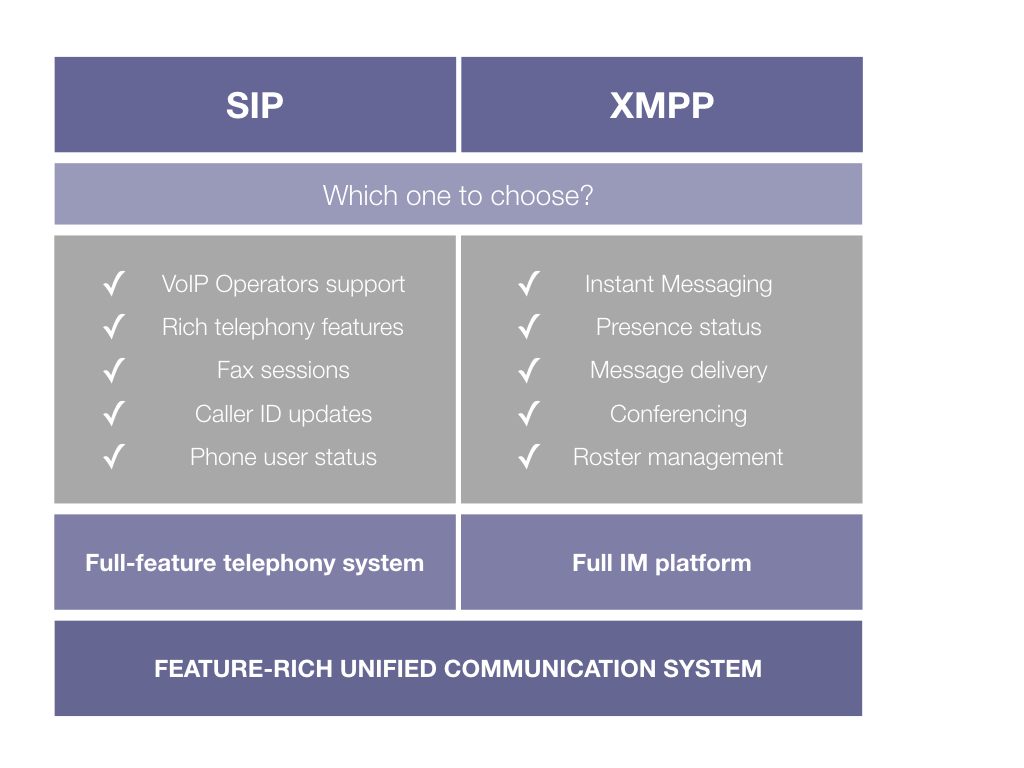
Slow your Roll

From VoIP to Unified Communications and WebRTC

 In this blog article we will discuss the basic standards used for real-time communications — SIP and XMPP — what is the difference, how each of them works, and, which one to choose.
In this blog article we will discuss the basic standards used for real-time communications — SIP and XMPP — what is the difference, how each of them works, and, which one to choose.
The IETF has two documented standards for real-time communications that are widely implemented: SIP and XMPP.
These standards transport text information and rely on other standards for the actual media transmission.
As both support real-time communications, many question which solution is most suited to their needs.
Let’s briefly explore the history and purpose of both.
Continue reading “SIP and XMPP standards in Unified Communications”
 According to Gartner AI promises to be the most disruptive class of technologies during the next 10 years (1). Wildix was among the first UC&C vendors to embed Artificial Intelligence capabilities into their communication platform back in 2017.
According to Gartner AI promises to be the most disruptive class of technologies during the next 10 years (1). Wildix was among the first UC&C vendors to embed Artificial Intelligence capabilities into their communication platform back in 2017.
Wildix calls this set of features “Wildix Business Intelligence,” or simply, WBI. Users of a Wildix System can already benefit from the following services:
Text-to-Speech service generates a sound file the moment a call is placed. You just have to write down a text—the moment a call is generated, this text is converted into speech. Audio files can be created in different languages using different female and male voices.
With channel variables, such as ${CALLERID(name)}, it is possible to create interactive voice responses. For example, make the system pronounce a welcome message that includes the caller name.
Continue reading “Is Artificial Intelligence the Next Major Technological Revolution?”

Web, Hybrid or Native Mobile apps – which one to choose? In the previous blog article we discussed web-based communication solutions and their advantages over native ones. This time we will discover why it is more preferable to use native or hybrid applications for mobile devices.
Mobile devices like smartphones and tablets have two important limitations:
Because these two factors must be taken into account, collaboration apps for mobile phones must still be native or hybrid apps. Native means using Objective-C and Swift (with iOS devices) and Java (with Android devices). Hybrid means that a mix of native code and Webviews are included in the app.
 Web-based VS native administration is a long-standing dispute within this field. This topic is particularly important because it defines all of the user’s experience. Let’s examine, why web-based communication solutions are the best choice for delivering high service quality.
Web-based VS native administration is a long-standing dispute within this field. This topic is particularly important because it defines all of the user’s experience. Let’s examine, why web-based communication solutions are the best choice for delivering high service quality.
All new products now use web-based administration interfaces. Gone are the days of interfaces made with Java / QT. The advantages of this change include:
If the communication system you are developing or deploying does not use a web-based interface, please reconsider your choice. Web-based is really the best option. Continue reading “Web-based vs Native apps: Which to Choose?”